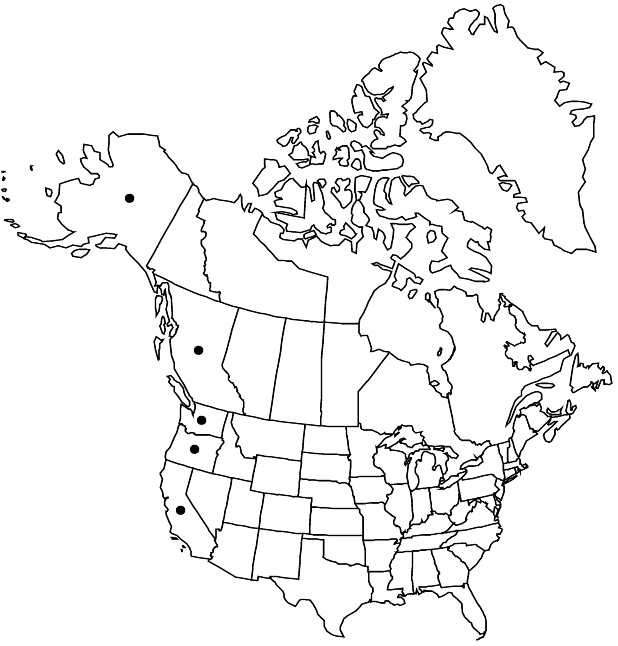Difference between revisions of "Ribes bracteosum"
in W. J. Hooker, Fl. Bor.-Amer. 1: 233. 1832 ,.
FNA>Volume Importer |
imported>Volume Importer |
||
| (5 intermediate revisions by 2 users not shown) | |||
| Line 1: | Line 1: | ||
{{Treatment/ID | {{Treatment/ID | ||
|accepted_name=Ribes bracteosum | |accepted_name=Ribes bracteosum | ||
| − | |accepted_authority=Douglas | + | |accepted_authority=Douglas |
|publications={{Treatment/Publication | |publications={{Treatment/Publication | ||
|title=in W. J. Hooker, Fl. Bor.-Amer. | |title=in W. J. Hooker, Fl. Bor.-Amer. | ||
| Line 7: | Line 7: | ||
}} | }} | ||
|common_names=Stink currant | |common_names=Stink currant | ||
| + | |special_status={{Treatment/ID/Special_status | ||
| + | |code=E | ||
| + | |label=Endemic | ||
| + | }} | ||
|basionyms= | |basionyms= | ||
|synonyms= | |synonyms= | ||
| Line 32: | Line 36: | ||
-->{{#Taxon: | -->{{#Taxon: | ||
name=Ribes bracteosum | name=Ribes bracteosum | ||
| − | + | |authority=Douglas | |
| − | |authority=Douglas | ||
|rank=species | |rank=species | ||
|parent rank=genus | |parent rank=genus | ||
| Line 46: | Line 49: | ||
|publication title=in W. J. Hooker, Fl. Bor.-Amer. | |publication title=in W. J. Hooker, Fl. Bor.-Amer. | ||
|publication year= | |publication year= | ||
| − | |special status= | + | |special status=Endemic |
| − | |source xml=https:// | + | |source xml=https://bitbucket.org/aafc-mbb/fna-data-curation/src/2e0870ddd59836b60bcf96646a41e87ea5a5943a/coarse_grained_fna_xml/V8/V8_21.xml |
|genus=Ribes | |genus=Ribes | ||
|species=Ribes bracteosum | |species=Ribes bracteosum | ||
Latest revision as of 22:42, 5 November 2020
Plants 1–4 m. Stems erect, with dense, yellowish, shiny, sessile, crystalline, round glands, sparsely pubescent throughout; spines at nodes absent; prickles on internodes absent. Leaves: petiole 2–10 cm, sparsely pubescent; blade ovate, deeply 5–7-lobed, cleft 1/2+ to midrib, (1.5–)2–10(–22) cm, base cordate, surfaces with yellow, dull, sessile glands and sparse hairs abaxially, with yellow, shiny, sessile glands and glabrous adaxially, lobes with main segments ovate-lanceolate, margins 1–2 times sharply serrate, apex acute, shallowly lobed. Inflorescences ascending to erect, 20–50-flowered racemes, (10–)15–30 cm, axis sparsely pubescent, flowers evenly spaced. Pedicels jointed, 5–12 mm, pubescent and glandular; bracts conspicuous, proximal ones ovate, lobed, distal ones narrowly oblong, unlobed, (3–)4–5 mm, sparsely glandular and pubescent. Flowers: hypanthium green, saucer-shaped, widely flared, 0.5–1.5 mm, ± pubescent and sparsely glandular abaxially, glabrous adaxially; sepals nearly to somewhat overlapping, spreading, brownish purple to greenish or sometimes nearly white, ovate-lanceolate to oblong-lanceolate, 3–5 mm; petals widely separated, erect, white, cuneate-flabelliform, not conspicuously revolute or inrolled, 1 mm; nectary disc wine red, thick, lobed, covering and submerging ovary; stamens slightly longer than petals; filaments linear to slightly broader at base, 1 mm, glabrous; anthers white, transversely oblong-cordate, 0.5 mm, broader than long, apex shallowly notched; ovary somewhat hairy and densely sessile-glandular; styles connate 1/4–1/2 their lengths, 1 mm, glabrous or hairy. Berries bland, black, subglobose, 8–10 mm, glandular. 2n = 16.
Phenology: Flowering Feb–Jun.
Habitat: Stream banks, moist woods, floodplains, shorelines, thickets, avalanche tracks
Elevation: 0-1700 m
Distribution

B.C., Alaska, Calif., Oreg., Wash.
Discussion
Ribes bracteosum occurs along the Pacific Coast from southeastern Alaska to northern California. Its thin leaves have a sweetish, disagreeable odor and the conspicuous bracts bear acicular, mostly persistent processes near the base along the slightly winged, stipular margins.
Selected References
None.